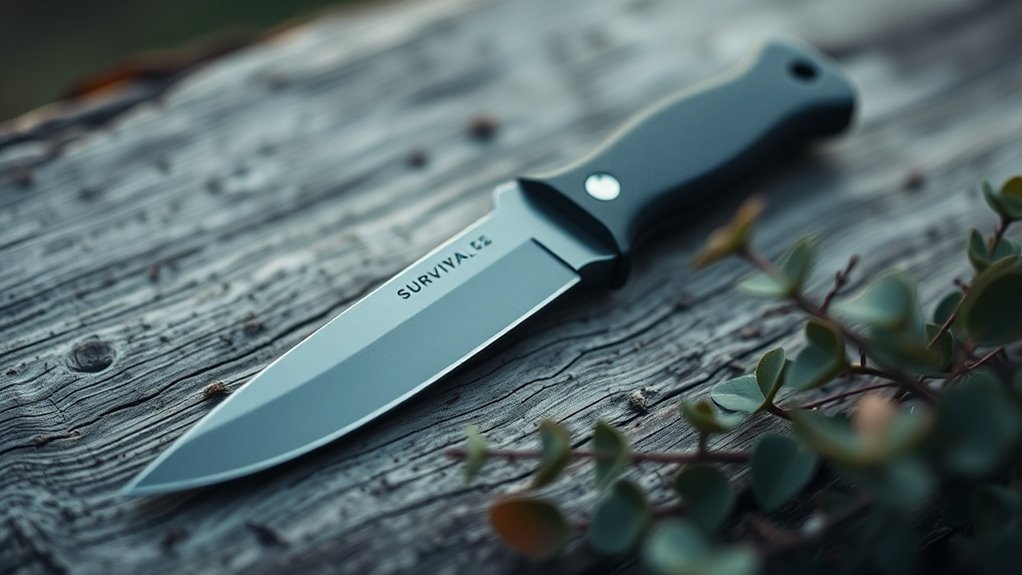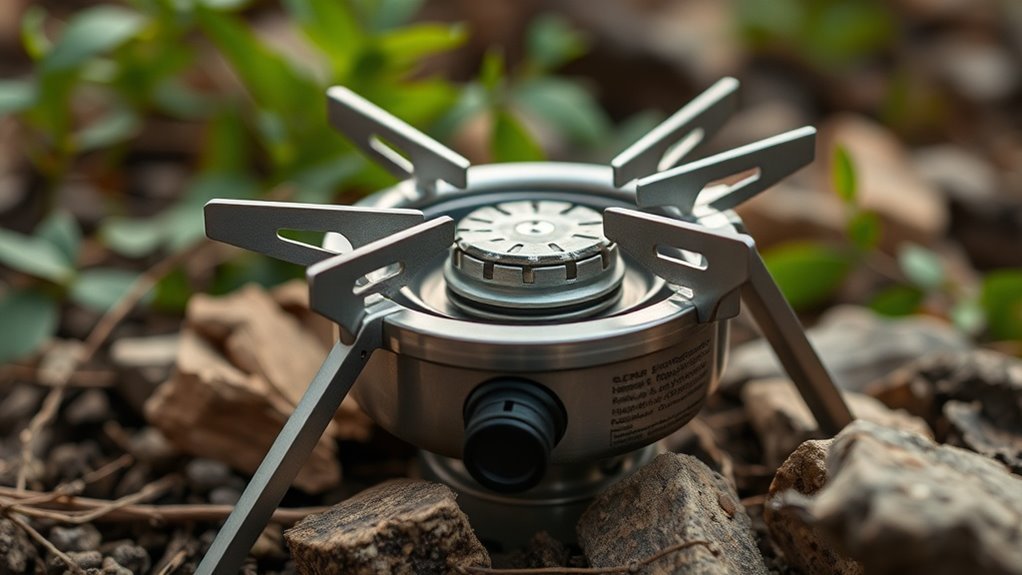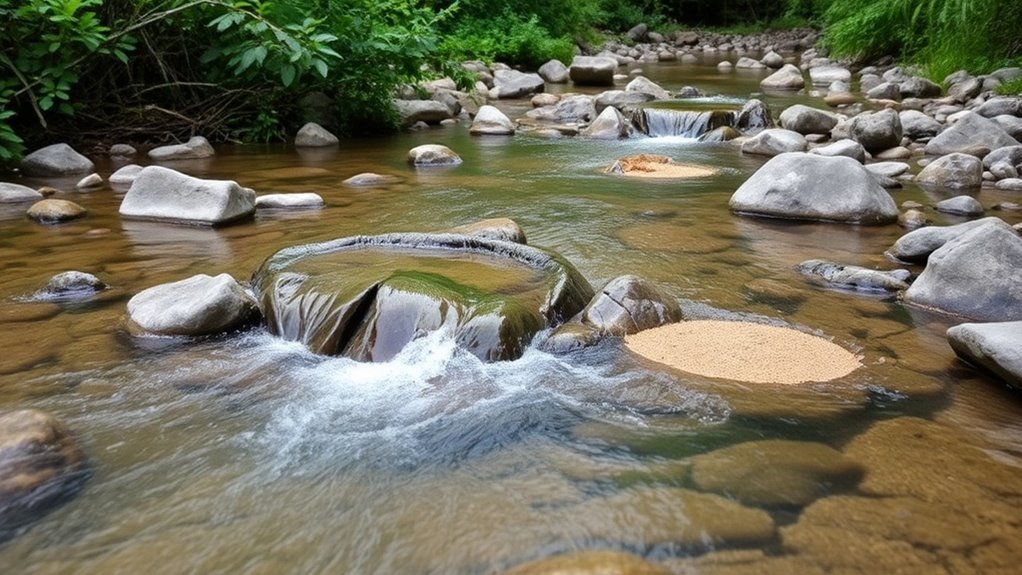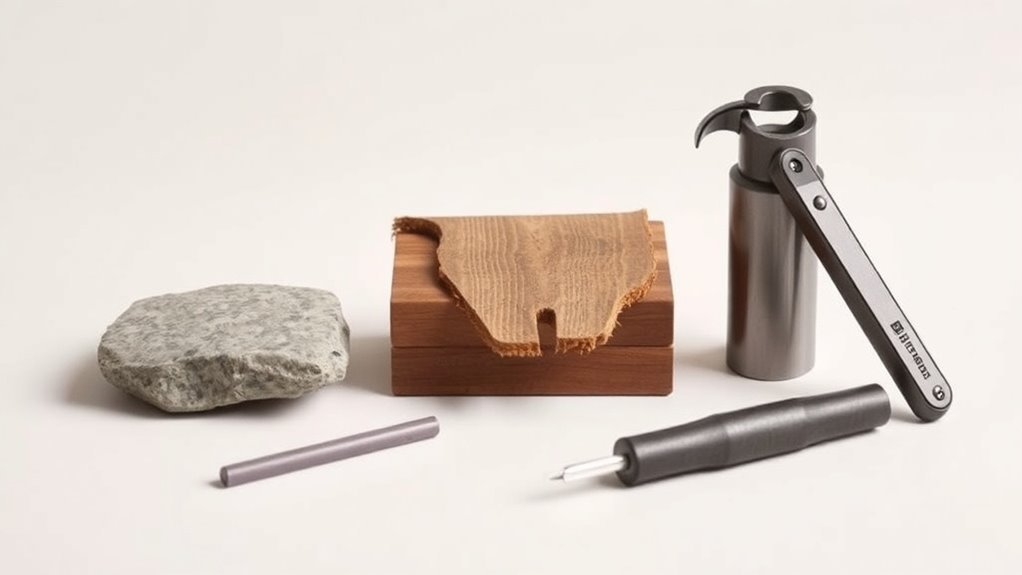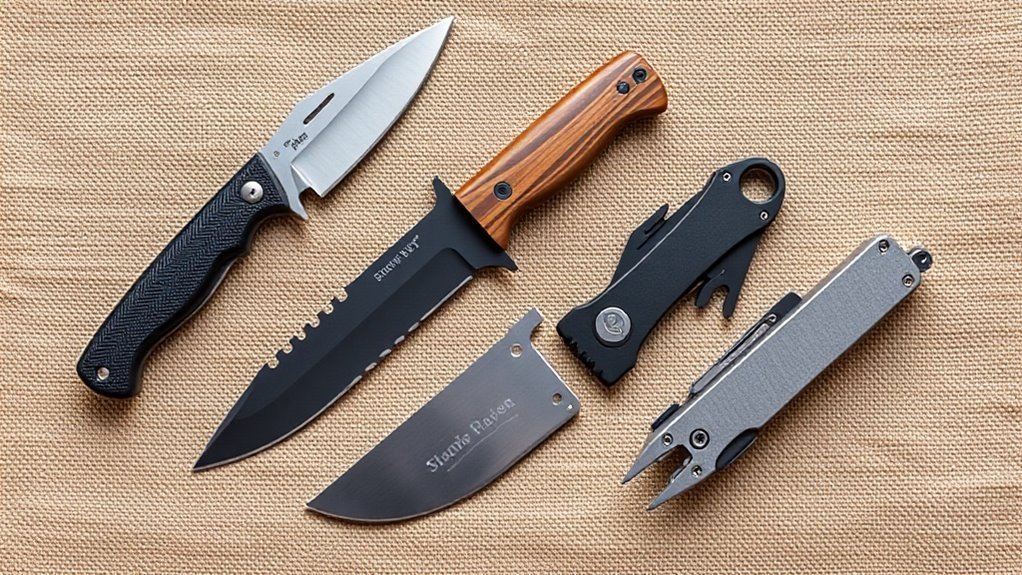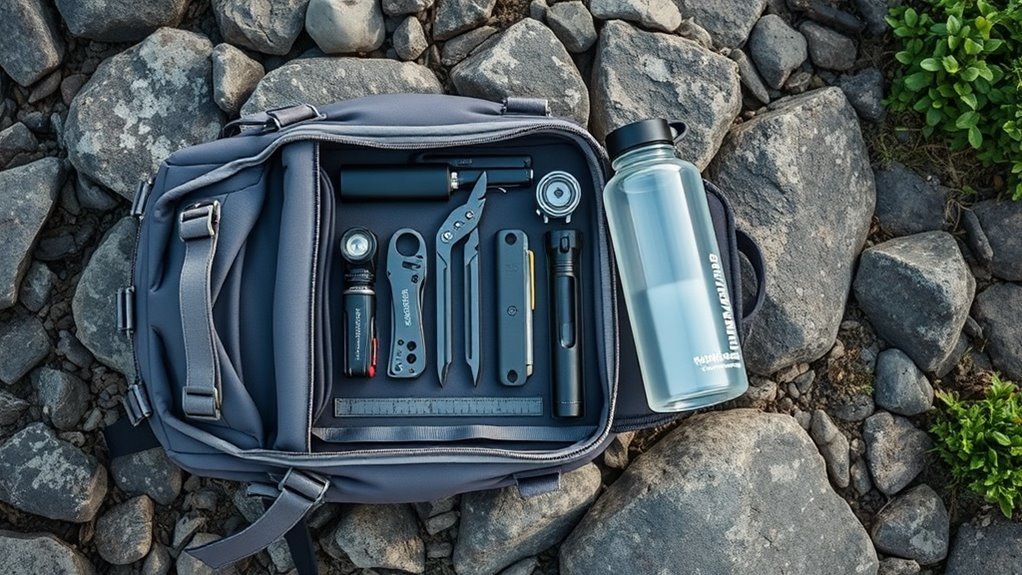First-Aid Tools Every Camper Should Carry
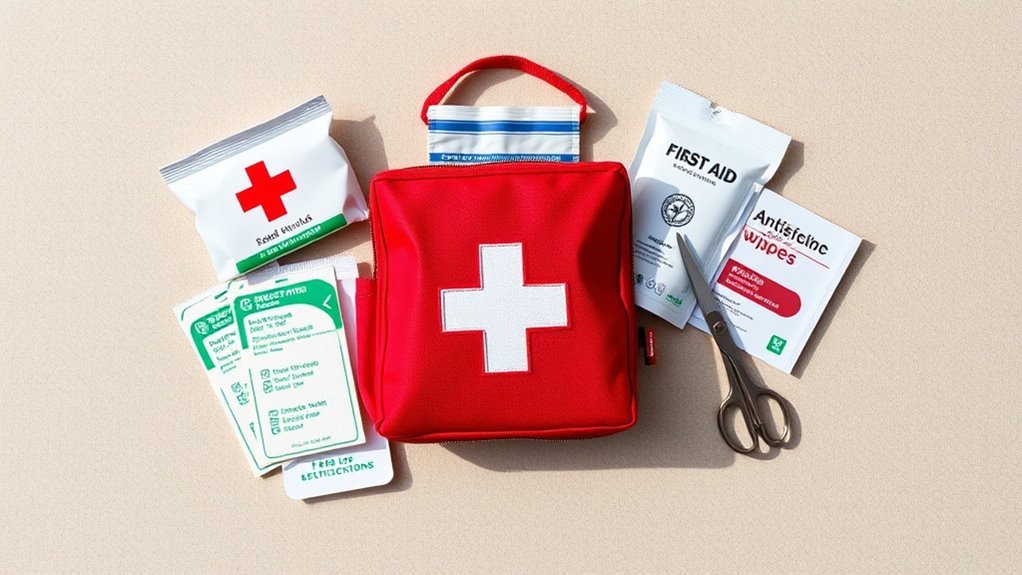
As a camper, you need to pack essential first-aid tools for safety. Include adhesive bandages, sterile dressings, antiseptic wipes, and creams to clean and protect wounds. Gauze pads and wraps are vital for larger injuries. Don’t forget pain relievers like ibuprofen or acetaminophen for discomfort. Also, bring tools for emergency response, like scissors and tweezers, as well as supplies for insect bites and stings. There’s more to reflect on to guarantee your outdoor adventures are safe.
Key Takeaways
- Include antiseptic wipes and creams to clean wounds and prevent infections, ensuring efficient first-aid treatment.
- Pack adhesive bandages in various sizes for quick coverage of minor cuts and blisters.
- Carry gauze pads and elastic bandages for larger wounds, providing necessary support and protection.
- Don’t forget pain relievers like ibuprofen and acetaminophen for managing discomfort and inflammation.
- Equip your kit with tweezers and scissors for effective removal of splinters and cutting tape or gauze.
Essential First-Aid Kit Components
When you’re out in the wild, a well-stocked first-aid kit can be your best friend. You’ll want to make sure your kit includes some foundational components.
Start with antiseptic wipes to clean wounds and prevent infection. Don’t forget adhesive tape and gauze pads for holding dressings in place. A pair of scissors and tweezers are essential too—scissors help with cutting gauze or tape, while tweezers can remove splinters or ticks.
Make sure to pack some pain relievers like ibuprofen or acetaminophen for headaches or muscle aches. Finally, having a CPR face shield can be a lifesaver in emergencies.
Adhesive Bandages and Sterile Dressings
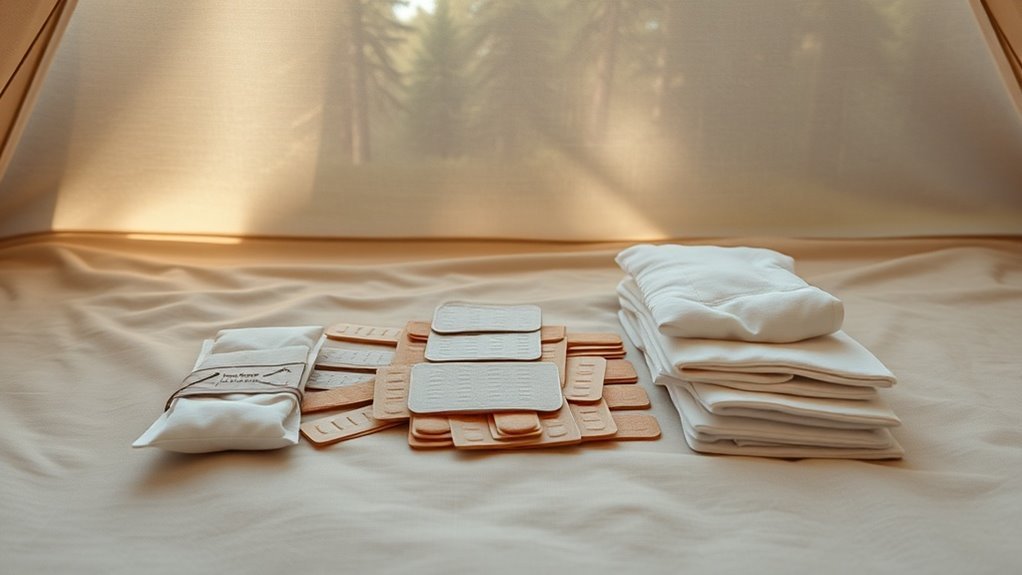
While enjoying the great outdoors, it’s easy to get minor cuts and scrapes, which is where adhesive bandages and sterile dressings come into play. Having them readily available helps you treat wounds quickly and effectively, preventing infection and promoting healing.
Here’s a quick reference table for your camping first-aid kit:
| Type | Use | Size |
|---|---|---|
| Adhesive Bandages | Small cuts and blisters | Assorted sizes |
| Sterile Dressings | Larger wounds or abrasions | 4×4 or larger |
| Waterproof Bandages | Wounds exposed to moisture | Assorted sizes |
Stock your kit with a variety of adhesive bandages and sterile dressings to cover any situation. Remember, being prepared can make all the difference on your outdoor adventures!
Antiseptic Wipes and Creams
When you’re out in the wild, keeping your wounds clean is vital, and that’s where antiseptic wipes and creams come into play.
Choosing the right product can make all the difference in preventing infections and promoting healing.
Let’s explore why these supplies are essential and how to pick the best options for your first-aid kit.
Importance of Antiseptic Wipes
Antiseptic wipes are essential for any camper’s first-aid kit, offering a quick and effective way to clean wounds and prevent infections. With their convenient packaging, you can easily pack them in your bag without adding bulk.
Using these wipes not only helps in cleaning cuts and scrapes but also guarantees you’re taking preventive measures against potential complications.
Here are a few reasons why you shouldn’t skip them:
- Convenience: Easy to use and perfect for on-the-go cleaning.
- Disinfection: They contain antimicrobial agents that effectively kill bacteria and viruses.
- Versatility: Great for cleaning hands, surfaces, or even gear prone to germs.
Having antiseptic wipes on hand can make a big difference in your camping experience.
Choosing the Right Cream
Selecting the right cream for your first-aid kit is essential, especially when heading into the wilderness. You’ll want to choose an antiseptic cream that effectively prevents infections and promotes healing. Look for creams that contain ingredients like benzalkonium chloride or hydrogen peroxide, as these help kill bacteria and soothe minor wounds.
Additionally, consider hypoallergenic options if you have sensitive skin.
It’s smart to have a pain-relieving cream or gel on hand as well, which can ease discomfort from insect bites or minor burns. Always check expiration dates, and pack a travel-sized tube for convenience.
Gauze Pads and Wraps
When you’re out camping, wound coverage is vital for preventing infection and aiding healing.
Gauze pads and wraps offer versatile ways to apply pressure and protect different types of injuries.
Knowing how to use them effectively can make a big difference in your first-aid response.
Wound Coverage Importance
Proper wound coverage is essential for preventing infection and promoting healing, especially in outdoor settings. When you’re camping, minor injuries can quickly become serious if not treated correctly.
Gauze pads and wraps are vital for protecting your wounds from dirt and bacteria. Here are some key benefits of using proper wound coverage:
- Prevents infection: Keeping the wound covered limits exposure to harmful pathogens.
- Promotes healing: A well-covered wound can heal faster by maintaining a moist environment.
- Reduces discomfort: Padding helps shield the wound from friction or impacts, easing pain.
Always pack adequate supplies of gauze pads and wraps in your first-aid kit.
Versatile Application Techniques
Sometimes, you might find yourself in a situation where quick and effective application of gauze pads and wraps can make all the difference.
To start, clean the wound gently with water or antiseptic wipes. Once cleaned, take a gauze pad and place it directly on the wound, applying just enough pressure to stop bleeding. If the bleeding continues, add additional layers of gauze without removing the first pad.
Next, wrap the area with elastic bandages, ensuring it’s snug but not too tight—this prevents cutting off circulation. Always secure the end with adhesive tape.
Finally, monitor for signs of infection and change the dressings regularly. Mastering these techniques can be lifesaving during your camping adventures.
Pain Relievers and Anti-Inflammatory Medications
Although you mightn’t expect it, pain relievers and anti-inflammatory medications are essential additions to any camper’s first-aid kit. Being out in nature can lead to unexpected aches and pains, so it’s important to be prepared.
Carrying the right medications can make a huge difference in your comfort and ability to enjoy the great outdoors.
Here are a few recommended options:
- Ibuprofen: Helps reduce inflammation and relieve pain from injuries or overexertion.
- Acetaminophen: Effective for minor aches, headaches, and fever reduction.
- Aspirin: Can be useful for pain relief and is also beneficial for heart health in certain situations.
Make sure you pack these meds, so you’re ready for anything your adventure throws your way!
Tweezers and Scissors
When you’re out camping, having a good pair of tweezers and scissors in your first-aid kit can be a game changer.
Tweezers are essential for removing splinters, ticks, or any small debris that might find its way into your skin. They provide the precision you need to address minor injuries without causing more harm.
Scissors, on the other hand, can help you cut bandages, clothing, or any other materials you might need in an emergency. Having both tools readily available lets you handle situations efficiently, ensuring you can focus on enjoying your camping trip instead of worrying about minor mishaps.
Make sure to keep them clean and easily accessible in your kit, so you’re always prepared for the unexpected.
Emergency Response Tools
In case of an emergency, having the right response tools can make all the difference in ensuring safety and swift action.
Here’s a list of essential tools you should include in your camping first-aid kit:
- First-aid manual: A well-illustrated guide helps you make informed decisions quickly.
- Emergency blanket: This lightweight and compact tool provides warmth and can be a lifesaver in shock situations.
- Multi-tool or knife: Versatile for various situations, it can assist in everything from cutting bandages to assisting with splints.
Packing these emergency response tools not only prepares you for unexpected situations but also gives you peace of mind.
Always remember to familiarize yourself with each tool’s use before your camping trip!
Burn Treatment Supplies
Burns can happen easily while camping, whether from cooking, campfires, or hot surfaces. To treat these injuries effectively, you should have a few essential burn treatment supplies in your first-aid kit.
Start with sterile gauze or burn dressings to cover the burn site and protect it from infection. You’ll also want to include a burn cream or gel with lidocaine for pain relief. Don’t forget medical tape to secure dressings in place.
Keep a pair of tweezers handy to remove debris if necessary. For larger burns, having a cold compress can help reduce swelling and discomfort.
Finally, make sure you’ve got a digital thermometer to check for fever, which could indicate infection. Preparedness is key for a safe camping experience!
Insect Bite and Sting Relief
When you’re out camping, insect bites and stings can really put a damper on your adventure. Knowing how to relieve the pain and irritation, along with some effective prevention tips, can make all the difference.
Let’s explore the best options to keep those pesky insects at bay and how to soothe any unwanted bites.
Effective Relief Options
Insect bites and stings can quickly turn a pleasant camping trip into an uncomfortable ordeal, but effective relief options are readily available.
Here are some handy solutions you should consider keeping on hand:
- Antihistamines: Over-the-counter options can reduce itching and swelling, providing much-needed comfort.
- Hydrocortisone cream: This topical treatment can minimize inflammation and ease irritation for localized relief.
- Cold compress: Applying a cold pack can numb the area and lessen swelling, offering immediate help for discomfort.
Having these essentials in your first-aid kit guarantees you’re prepared to tackle insect-related woes.
Stay proactive, and don’t let bites or stings ruin your outdoor adventure!
Prevention Tips and Tricks
To guarantee your camping experience remains enjoyable, it’s essential to employ proactive measures against insect bites and stings. Start by wearing long sleeves and pants, especially during dawn and dusk when insects are most active. Use insect repellent containing DEET, and reapply as needed. Make sure you’re camping in cleared areas away from standing water, which attracts pests. Keeping your food sealed can help reduce unwanted visits from insects. Finally, consider natural deterrents like citronella candles for added protection.
| Prevention Tip | Description |
|---|---|
| Wear Protective Clothing | Opt for long sleeves and pants. |
| Use Insect Repellent | Choose one with DEET for maximum effect. |
| Select Camping Sites | Avoid areas near standing water. |
| Seal Food Properly | Store food in airtight containers. |
| Use Natural Deterrents | Incorporate citronella candles. |
Special Considerations for Outdoor Environments
Although camping can be an exhilarating experience, it also presents unique challenges for first aid. The outdoor environment introduces various factors that require special consideration.
Camping offers excitement but also unique first aid challenges that require careful preparation and awareness of the outdoor environment.
You’ll need to be prepared for potential hazards that aren’t common in everyday life.
- Wildlife encounters: Be aware of local animals that may pose risks, like snakes or bears. Carry bear spray or other deterrents.
- Elevation and temperature changes: Sudden altitude shifts can lead to altitude sickness, and temperature fluctuations may cause hypothermia or heat exhaustion, so pack appropriate clothing.
- Insect bites and stings: Carry antihistamines and other treatments for severe allergic reactions or infections resulting from bites.
Additionally, consider carrying solar-powered gear, such as portable solar panels, which can ensure you have access to reliable power for charging devices in case of an emergency while enjoying the wilderness.
Keeping these factors in mind can guarantee you’re better equipped to handle emergencies in a wilderness setting.
Questions
How Do I Choose the Right Size First-Aid Kit for Camping?
To choose the right size first-aid kit, consider the number of campers, trip duration, and activities planned. A smaller kit suffices for short trips, while larger kits suit extended excursions or more adventurous activities.
Can I Make My Own First-Aid Kit Instead of Buying One?
Yes, you can definitely make your own first-aid kit! Just guarantee you include essential items like bandages, antiseptic wipes, and any personal medications. Tailoring it to your needs makes it even more effective.
How Should I Store My First-Aid Kit While Camping?
Storing your first-aid kit’s like safeguarding a treasure; keep it dry, insulated, and easy to reach. Choose a sturdy, waterproof container, and hang it high or pack it where it won’t get crushed.
Are There Any Specific First-Aid Items for Kids?
You should pack kid-friendly items like adhesive bandages with fun designs, children’s pain relievers, hydrocortisone cream for rashes, and insect bite relief sticks. These items can make treating minor injuries easier for both you and the kids.
When Should I Seek Professional Medical Help While Camping?
You should seek professional medical help while camping if you experience severe injuries, persistent pain, difficulty breathing, signs of infection, or if a condition doesn’t improve with basic first aid. Trust your instincts; don’t hesitate.
Conclusion
Packing the right first-aid tools can be the lifeline between adventure and misadventure. Just like a sturdy tent shields you from storms, your first-aid kit safeguards against the unexpected bumps along the trail. As you venture into the wild, remember that a little preparation can turn a potential crisis into a mere hiccup. So gear up, keep your kit stocked, and let the great outdoors become your playground, not a battleground. Happy camping!

